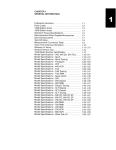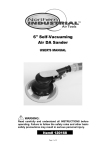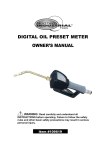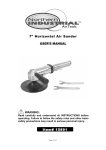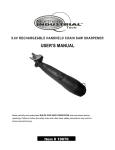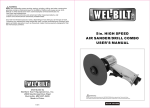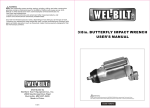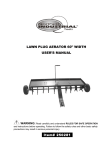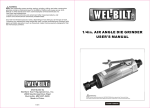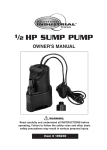Download CONCRETE SAW W/ 265cc ROBIN
Transcript
CONCRETE SAW W/ 265cc ROBIN OWNER’S MANUAL WARNING: Read carefully and understand all INSTRUCTIONS before operating. Failure to follow the safety rules and other basic safety precautions may result in serious personal injury. It e m # 9 9 8 0 0 3 Thank you very much for choosing a NORTHERN TOOL + EQUIPMENT CO., INC. Product! For future reference, please complete the owner’s record below: Model: _______________ Purchase Date: _______________ Save the receipt, warranty and these instructions. It is important that you read the entire manual to become familiar with this product before you begin using it. This machine is designed for certain applications only. Northern Tool + Equipment cannot be responsible for issues arising from modification. We strongly recommend this machine is not modified and/or used for any application other than that for which it was designed. If you have any questions relative to a particular application, DO NOT use the machine until you have first contacted Northern Tool + Equipment to determine if it can or should be performed on the product. For technical questions please call 1-800-222-5381. INTENDED USE TECHNICAL SPECIFICATIONS Maximum Cutting Depth 4-1/5" Deep Drive System Belt Drive (Qty.2)/V-Belts/1/2" Wide Blade Specifications 14" Diameter (not included) / Blade RPM: 4500 Arbor Size 3/4" Diameter Bushing on a 1" Arbor Water Connection Size 3/4"-11.5 NHT(Garden Hose Thread) Cutting Capability Left and Right Wheel Base Length 13-4/5" Engine 265cc Robin Additional Features Engine Low Oil Shut-Off/Height Position Lock/Speed Control Overall Dimensions 46" Long x 21-2/5" Wide x 39-3/8" High Weight 172 Pounds IMPORTANT! This product requires oil and fuel to be added before starting. Attempting to start the Engine without oil WILL ruin the Engine and Void the warranty. NOTE: The Engine’s carburetor may need to be adjusted by a qualified mechanic for efficient high-altitude use. GENERAL SAFETY RULES WARNING: The warnings, cautions, and instructions discussed in this instruction manual cannot cover all possible conditions or situations that could occur. It must be understood by the operator that common sense and caution are factors which cannot be built into this product, but must be supplied by the operator. WARNING: Carbon Monoxide produced during use can kill. Do not use indoors or in other sheltered areas. Page 2 of 11 SAVE THESE INSTRUCTIONS WORK AREA Keep work area clean, free of clutter and well lit. Cluttered and dark work areas can cause accidents. Do not use your tool where there is a risk of causing a fire or an explosion; e.g. in the presence of flammable liquids, gasses, or dust. Power tools create sparks, which may ignite the dust or fumes. Keep children and bystanders away while operating a power tool. Distractions can cause you to lose control, so visitors should remain at a safe distance from the work area. Be aware of all power lines, electrical circuits, water pipes and other mechanical hazards in your work area, particularly those hazards below the work surface hidden from the operator’s view that may be unintentionally contacted and may cause personal harm or property damage. Be alert of your surroundings. Using power tools in confined work areas may put you dangerously close to cutting tools and rotating parts. INTERNAL COMBUSTION ENGINE SAFETY WARNING: Internal combustion engines present special hazards during operation and fueling. Read and follow the warning instructions in the engine Owner’s Manual and the safety guidelines below. Failure to follow the warnings and safety standards could result in severe injury or death. DO NOT run the machine indoors or in an enclosed area such as a deep trench unless adequate ventilation, through such items as exhaust fans or hoses, is provided. Exhaust gas from the engine contains poisonous carbon monoxide gas; exposure to carbon monoxide can cause loss of consciousness and may lead to death. DO NOT smoke while operating the machine. DO NOT smoke when refueling the engine. DO NOT refuel a hot or running engine. DO NOT refuel the engine near an open flame. DO NOT spill fuel when refueling the engine. DO NOT run the engine near open flames. ALWAYS refill the fuel tank in a well-ventilated area. ALWAYS replace the fuel tank cap after refueling. ALWAYS check the fuel lines and the fuel tank for leaks and cracks before starting the engine. Do not run the machine if fuel leaks are present or the fuel lines are loose. PERSONAL SAFETY Stay alert, watch what you are doing and use common sense when operating a power tool. Do not use a power tool while you are tired or under the influence of drugs, alcohol or medication. A moment of inattention while operating power tools may result in serious personal injury. Dress properly. Do not wear loose clothing, dangling objects, or jewelry. Keep your hair, clothing and gloves away from moving parts. Loose clothes, jewelry or long hair can be caught in moving parts. Air vents often cover moving parts and should be avoided. Use safety apparel and equipment. Use safety goggles or safety glasses with side shields which comply with current national standards, or when needed, a face shield. Use as dust mask Page 3 of 11 in dusty work conditions. This applies to all persons in the work area. Also use non-skid safety shoes, hardhat, gloves, dust collection systems, and hearing protection when appropriate. Avoid accidental starting. Make sure the engine power switch is in the “OFF” position while transporting. Do not overreach. Keep proper footing and balance at all times. Remove adjusting keys or wrenches before connecting to the power supply or turning on the tool. A wrench or key that is left attached to a rotating part of the tool may result in personal injury. TOOL USE AND CARE Always keep all parts of your body away from the blade and all other moving parts. Do not force the tool. Tools do a better and safer job when used in the manner for which they are designed. Plan your work, and use the correct tool for the job. Never use a tool with a malfunctioning switch. Any power tool that cannot be controlled with the switch is dangerous and must be repaired by an authorized service representative before using. Store idle tools. When tools are not is use, store them in a dry, secure place out of the reach of children. Inspect tools for good working condition prior to storage and before re-use. Maintain your tools. It is recommended that the general condition of any tool be examined before it is used. Keep your tools in good repair by adopting a program of conscientious repair and maintenance in accordance with the recommended procedures found in this manual. If any abnormal vibrations or noise occurs, turn the tool off immediately and have the problem corrected before further use. Have necessary repairs made by qualified service personnel. Keep cutting tools sharp and clean. Properly maintained cutting tools with sharp cutting edges are less likely to bind and are easier to control. Keep handles dry, clean, and free from oil and grease. Use only accessories that are recommended by the manufacturer for your model. Accessories that may be suitable for one tool may create a risk of injury when used on another tool. Keep guards in place and in working order. Never leave tool running unattended. Always shut off the engine and allow it to cool before refueling. Only use blades marked with a maximum operating speed greater than the blade shaft speed. Use caution and follow the instructions when loading and unloading the saw. Do not use damaged blades. Never touch the engine or muffler while the engine is on or immediately after it has been turned off. These areas get hot and may cause burns. Never operate the machine with the belt guard missing. Exposed drive belt and pulleys create potentially dangerous hazards that can cause serious injuries. Never leave the machine running unattended. Always be sure operator is familiar with proper safety precautions and operation techniques before using machine. Always close fuel valve on engines when machine is not being operated. Always operate machine with all safety devices and guards in place and in working order. DO NOT modify or defeat safety devices. DO NOT operate machine if any safety devices or guards are missing or inoperative. Page 4 of 11 Always make sure the engine’s power switch is in the “OFF” position, the spark plug wire is disconnected from the engine, and the engine is completely cool performing any inspection, maintenance, or cleaning of the saw and its engine. Do not allow other persons to be near the saw when starting, refueling or when cutting. Remove the blade prior to hoisting, loading, unloading and transporting the machine. ASSEMBLY 1. Make sure the power is off, and the spark plug wire is disconnected from the engine of the concrete saw. 2. To install a Saw Blade (not included) on the RIGHT SIDE of the Concrete Saw, make sure the Blade Shaft (8), Inner Blade Collar (10), and Outer Blade Collar (11) are clean and free of dirt and debris (See figure A, next page and Figure C). 3. Remove the Hex Bolt (48) and Outer Blade Collar (11) (See Figure A). 4. Install the Saw Blade onto the Blade Shaft (8). Make sure the arrow depicted on the Saw Blade points in the same direction as the arrow depicted on the Blade Guard Assembly (36) (See figure A). 5. Replace the Outer Blade Collar (11). Make sure the Offset drive Pins on the Inner Blade Collar (10) and Outer Blade Collar line up with the corresponding holes in the Saw Blade (See figure A). 6. Firmly tighten the Hex Bolt (48) back into the Blade Shaft (8) (See figure A). OFFSET DRIVE PIN INNER Blade Collar (10) OUTER Blade Collar (11) HEX Bolt (48) Saw Blade FIGURE A Left side installation of blade: 1. Remove the Shaft Cover Assembly (33) as shown in figure B. 2. Remove the Hex Bolt (48), Outer Blade Collar (11), Saw Blade, and Inner Blade Collar (10) (See figure A). Page 5 of 11 3. Re-install the Inner Blade Collar (10), Saw Blade, Outer Blade Collar (11), and Hex Bolt (48) on the Blade Shaft (8) located on the other side of the Concrete Saw (See figure A). 4. Remove the Blade Guard Assembly (36), and re-install on the other side of the Concrete Saw (See figure B). 5. Re-install the Shaft Cover Assembly (33) on the side of the unit (See figure B). 6. Make sure the Water Hose (29) is kept clear of hot and moving parts of the Concrete Saw (See figure B). FRONT VIEW OF UNIT WATER HOSE (29) SHAFT COVER (33) BLADE GUARD (36) FIGURE B OPERATION IMPORTANT! Your Warranty is voided if you do not put engine oil in the Engine’s crankcase prior to its first use. Before each use, check the oil level. Never run the Engine with low or no engine oil. Running the Engine with low or no Engine oil will permanently damage the Engine. 1. Make sure the Engine (30) of the Concrete Saw is filled with the proper amount of oil and unleaded gasoline recommended by the Engine manufacturer before attempting to start the Engine. Failure to do so WILL damage the Engine and void the warranty (See Engine manufacturer’s instruction manual). 2. Check to make sure the V-Belts (35) are properly tensioned. (See page 11 of this manual.) At any time the Concrete Saw is being transported the Saw Guide (21) must be in its locked (upward) position and the Pointer (24) in its downward position. (See Figure C.) POINTER (24) SAW GUIDE (21) FIGURE C 3. If you have mounted a wet cutting Saw Blade, attach the Concrete Saw to a water supply. To do so, thread a standard garden hose onto the threads of the Swivel Hose Fitting (26). Page 6 of 11 The flow of water is regulated with the Service Lever (28). Make sure the Service Lever is closed and turn on the water supply at the source. When the Service Lever is in the “ON” position, the water will flow out of the Water Hose (29) and into the Water Manifold (38) on the Blade Guard Assembly (36). (See Figure D.) HAND WHEEL (17) WATER HOSE (29) SERVICE LEVER (28) WATER MANIFOLD (38) BLADE GUARD (36) SAW GUIDE (21) SWIVEL HOSE FITTING (26) POINTER (24) FIGURE D 4. Turn the Hand Wheel (17) clockwise to raise the Saw Blade off the concrete surface (See Figure D). 5. Lower the Saw Guide (21). Then lower the Pointer (24) and adjust the Pointer to guide the Concrete Saw along the cut line. (See Figure D.) 6. Start the Engine (30), and allow it to reach the appropriate operating temperature as instructed in the Engine manufacturer’s instruction manual. WARNING! The Saw Blade will immediately begin to spin. Stand clear! Always operate the Saw at full throttle. 7. Lower the Saw Blade slowly to make contact with the concrete surface by turning the Hand Wheel (17) counterclockwise until you have reached the desired depth (maximum depth is 4-3/4"). (See Figure D.) 8. This is not a self-propelled machine. You must exert force to move the Concrete Saw. Slowly move the Concrete Saw forward with just enough pressure to make the Engine labor. If the Engine begins to stall, you are moving too fast and you need to pull back. 9. IMPORTANT: a. Keep the Saw Blade perpendicular to the concrete surface. Avoid twisting or any excessive sideways motion which will stress the Saw Blade. b. When cutting deep (4" or more), make several shallow passes at 1-1/2" to 2" deep. c. If the Engine stalls, use the Hand Wheel (17) and lift the Saw Blade completely out of the concrete surface before re-starting. (See Figure D.) 10. When finished cutting, turn the Hand Wheel (17) clockwise to raise the Saw Blade. Then turn off the Engine and the water supply. (See Figure D.) 11. Prior to moving the Concrete Saw away from the worksite, the Saw Guide (21) must be in its locked (upward) position and the Pointer (24) in its downward position. (See Figure D.) 12. Always store the Concrete Saw in a clean, dry, safe location out of reach of children and other unauthorized people. MAINTENANCE Page 7 of 11 WARNING: Never perform any services or maintenance on the Concrete Saw while it is running. Before performing any inspection, maintenance, and cleaning, turn off the Engine (30) and disconnect the Spark Plug Wire from the Spark Plug to prevent accidental starting. Then, allow the Engine to completely cool. Before each use: Inspect the general condition of the Concrete Saw. Check for loose bolts and nuts, misalignment, binding of moving parts, loose or broken parts, Engine problems, dull or damaged Saw Blade, and any other condition that may affect the safe operation of the Concrete Saw. If abnormal noise or vibration occurs, turn off the Concrete Saw immediately and have the problem corrected before further use. Do not use damaged equipment. Engine maintenance: Refer to the Engine manufacturer’s service manual for instructions. V-belt maintenance: The V-belts (35) require periodic adjustment for proper tension and alignment. Tension: Tighten frequently during the first few days of operation and check periodically thereafter. Tighten the V-belts just enough to prevent slippage. Do not over tighten as excessive wear will occur to the V-belts and Bearings. To adjust the V-belts, loosen the Engine bolts and slide the Engine backwards or forwards to loosen or tighten the V-belts. For fine adjustment, use the Engine Adjustment Bolt located near the front of the Engine. (See Engine manufacturer’s service manual.) Alignment: The Engine Pulley (34) and Blade Shaft Pulley (12) should be parallel when properly aligned. To do so, place a straight edge along the face of the Pulleys and check to see if they are parallel. Loosen the Pulleys, and readjust if necessary. (See Assembly diagram.) V-belt replacement: When replacing worn out V-belts (35), make sure you replace the V-belts with a matching set of new V-belts. To do so, loosen the Pulleys (34, 12) and replace the V-belts. Correct tension is obtained when there is approximately 1/4" deflection of the V-belts at the center span of the Engine Pulley (34) and Blade Shaft Pulley (12). After replacement, run the Concrete Saw at 3/4 speed for 15 minutes to seat the V-belts. Then, open to full throttle to check for V-belt slippage. (See Assembly diagram.) Bearing maintenance: The Blade Shaft Bearing (9) should be lubricated every 8 hours of operation. Use rust inhibiting, lithium base grease with a consistency of NLGI 3. Thoroughly clean the Grease Fitting (41). Apply grease slowly while rotating the Blade Shaft Bearing (9) until fresh grease purges from the Bearing. To prevent damaging the Bearing Seals, avoid applying excessive pressure. (See Assembly diagram.) To clean: Thoroughly clean the concrete saw at the end of each day’s operation with clean water and a mild detergent. Do not pour water over the Engine (30). Refer to the Engine manufacturer’s service manual for all inspection, maintenance, and cleaning procedures. Page 8 of 11 EXPLODED DIAGRAM Page 9 of 11 PARTS LIST Part Description Qty. Part Description Qty. 1 Chassis Assy. 1 26 Swivel Hose Fitting 1 2 Rear Wheel 2 27 Hose Washer 2 3 Rear Axle Bearing 2 28 Service Lever 1 4 Splash Guard 2 29 Water Hose 1 5 Pivot Frame Assy. 1 30 Gas Engine 1 6 Front Wheel 2 31 Back Belt Guard 1 7 Set Screw Collar 2 32 Front Belt Guard 1 8 Blade Shaft 1 33 Shaft Cover Assy. 1 9 Blade Shaft Bearing 2 34 Engine Pulley 1 10 Inner Blade Collar 1 35 V-belt 2 11 Outer Blade Collar 1 36 Blade Guard Assy. 1 12 Pulley 1 37 Blade Wrench 1 13 Handle 2 38 Water Manifold 1 14 Screw Jack Holder 1 39 Brass Water Pipe 2 15 Screw Jack 1 40 Guard Lock 3 16 Bearing Bracket Adjuster 1 41 Grease Fitting 6 17 Hand Wheel Assy. 1 42 Hose Clamp 2 18 Screw Jack Nut 1 43 Hose Nipple 1 19 Handle Wheel Knob 1 44 Blade Splash Guard 1 20 Handwheel Lock Pin 1 45 Screw Jack Nut 1 21 Saw Guide 2 46 Hex Bolt 1 22 Guide Wheel 1 47 Hex Bolt 1 23 Washer Spacer 2 48 Hex Bolt 1 24 Pointer 1 49 Saw Depth Stop 1 25 Nut 1 50 Outer Circlip 2 Page 10 of 11 WARNING Engine exhaust contains or emits chemicals known to the State of California to cause cancer and birth defect or other reproductive harm. WARNING Some dust created by power sanding, sawing, grinding, drilling, and other construction activities contains chemicals known to the State of California to cause cancer, birth defects or other reproductive harm. Some examples of these chemicals are: • lead from lead-based paints, • crystalline silica from bricks and cement and other masonry products, and • arsenic and chromium from chemically-treated lumber. Your risk from these exposures varies, depending on how often you do this type of work. To reduce your exposure to these chemicals: work in a well ventilated area, and work with approved safety equipment, such as those dust masks that are specially designed to filter out microscopic particles. Northern Tool + Equipment Co., 2800 Southcross Drive West P.O. Box 1499 Burnsville, MN 55337-0499 Made in China. Page 11 of 11












